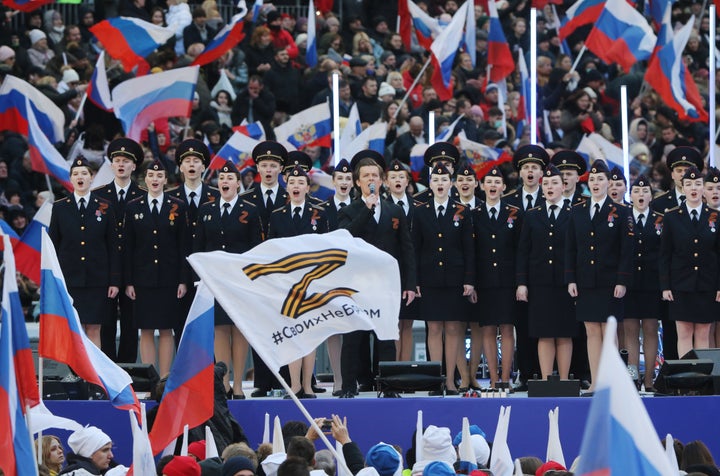Earlier this month, Russian President Vladimir Putin made it illegal for media to spread what his regime considers to be false information about Russia’s war in Ukraine ― or what the rest of the world considers the truth. Reporting about how Russian forces invaded with no legitimate cause and are presently bombing civilian infrastructure indiscriminately, for instance, could land you behind bars for up to 15 years.
According to Putin and Russian state media, Russian forces are “denazifying” their Ukrainian neighbors, liberating them from widespread oppression and genocide. Putin repeated these false claims on Friday during a huge flag-waving rally at a Moscow stadium packed with Russian celebrities and a crowd that may have largely contained government employees obliged to be there.
The claims are absurd. Ukraine is led by a Jewish man, President Volodymyr Zelenskyy, and there is no evidence of any sort of genocide in the country. A United Nations investigation turned up nothing.
But a lot of what gets presented as truth by Russian officials and fair reporting by its state media sounds absurd.
Take the suggestion, made by Russia’s representative at the United Nations Security Council, that the U.S. and Ukraine have been plotting to use migratory birds and other winged creatures to spread deadly pathogens. A Russian defense ministry spokesman suggested the pathogens could cross into Russia.

It’s part of a wider conspiracy theory, spread by Russian and Chinese media ― along with Fox News’ Tucker Carlson ― that the United States has been funding “secret biolabs” in Ukraine to concoct dangerous biological weapons. As Poynter explained in detail, there are labs in Ukraine funded by the U.S., Canada, the European Union and the World Health Organization that research pathogens, but that is not the same as weaponizing them.
The “biolabs” idea has raised suspicion that Russia may be planning to unleash some kind of chemical or biological weapon of its own in Ukraine; the U.S. ambassador to the U.N. called the possibility “deeply troubling.”
One version of the theory is especially fantastical.
“The Kremlin justifies its intervention in the eyes of the Russians by saying that the Americans created strains that affect Russians selectively, on a genetic basis,” said Maria Avdeeva, research director of the European Expert Association, which studies disinformation.
“This is the most base lie, aimed at the most poorly educated groups of the population, who unconditionally believe in the Kremlin propaganda,” she said in an email to HuffPost.
(Avdeeva is still living in her native city of Kharkiv, Ukraine, which is being systematically destroyed by Russian bombs. She posts videos of the destruction to her Twitter account.)
Another Russian official recently accused Zelenskyy of plotting to build “a dirty bomb” at the Zaporizhzhia nuclear power plant, thereby justifying Russian forces’ attack on it. Russia is now in control of the plant.
It is unclear how many people inside Russia actually buy the stories that Putin is selling. Avdeeva said the bulk of the Russian population is passive, unwilling to take a strong stance either way. But some Ukrainians say their Russian family members contradict their word on what’s happening in Ukraine, believing that Putin is at the very least doing an honorable thing.
Propaganda is a powerful tool. For years, Russian officials and state media have “pre-conditioned” Russian people to treat Ukraine with some suspicion, said Anton Shirikov, a disinformation researcher at the University of Wisconsin at Madison.
“What propaganda is saying right now, and what it has been saying for the past 10 or more years, is that Putin is restoring Russia’s greatness, but there are people who are against it, and Ukraine is sort of the battlefield for that,” Shirikov said.
“For a long time, Russian propaganda was repeating the same lies: ‘The United States entered Ukraine and turned it into a radical, anti-Russian state,’ ‘Ukrainian people are friendly to Russia, but not the Kyiv regime, led by the U.S.,’ or ‘This war is inevitable because Russia is defending its right to exist,’” Avdeeva said.
The Kremlin was making similar accusations against Ukraine eight years ago when Russian forces took over the Crimean Peninsula, a southern region of Ukraine that is also home to Russian-backed separatists.
“They were saying there were fascists in Ukraine even back in 2014,” said Shirikov.
Avdeeva said the propaganda fits into two groups ― more or less straightforward disinformation meant for the Russian population and more elaborate disinformation meant for Russian sympathizers around the world, including in the West. Right now, she said, Russians are being fed “outrageous lies dehumanizing Ukrainians and legitimizing onslaught.”
On RT, a Russian state news channel, reporters muddied the information waters during a segment on the Mariupol theater bombing. The massive theater was serving as a shelter for a reported 1,300 people, largely women, children and the elderly. It even had the Russian word for “children” written in large letters on the ground outside, but was still demolished by a Russian bomb. How many survived the attack is still unknown due to the grueling Russian siege of Mariupol.
RT reporter Maria Finoshina suggested Thursday that the theater was actually being used as a base of operations for a far-right Ukrainian nationalist group, with the children acting as “human shields.” She floated the idea that the far-right Ukrainians blew up the base as they deserted it.
“Who did this? We still are receiving conflicting reports,” Finoshina said in English.
Similarly, despite clear evidence of Russian forces bombing hospitals in Ukraine, Russian officials deny such attacks, blaming them instead on the Ukrainian nationalists. In Russian media, its troops use artillery in a very precise manner and do not attack civilians. The Russian Embassy in the U.K. claimed that a photograph of a bloodied pregnant woman fleeing a maternity ward in Mariupol was staged, and the woman pictured was an actor.
She was not. The Associated Press found that the woman, Mariana Vishegirskaya, had blogged about her (very real) pregnancy and later gave birth to a daughter. Another woman who initially survived the hospital attack was pictured on a stretcher holding her stomach, but she later died along with her child, having suffered a broken pelvis.
“The Kremlin reacts to any of its failures, mistakes and miscalculations in the same way ― with lies, insinuations, unthinkable propaganda,” Avdeeva said.
Russian propagandists are known to sometimes use actors themselves, Shirikov said, or regular people who are told what to say. But he also stressed that Ukraine is a large country, home to 40 million people before the war began making refugees out of many, and said he did not think it would be hard to find a small handful of people genuinely willing to criticize Ukraine in favor of Russia.
Even if the vast majority of Ukrainians are against the war, the Russian disinformation machine has shown that it will use anything it can to buoy its arguments. Instructions were reportedly sent out to state media to incorporate soundbites of Tucker Carlson casting doubt on NATO leadership during his popular evening program.
The long-term result of all this propaganda is that people can be left unsure of what to believe. Complicating matters are the Western sanctions and voluntary boycotts against Russia that have left its people more cut off from the rest of the world than they have been in decades.
“I think part of the idea here is that they try to put out everything they can, just hoping that some of it will stick, or hoping people will see it and think ... some of it must be true,” Shirikov said.

